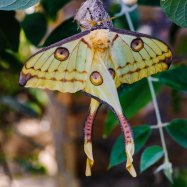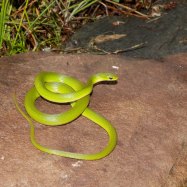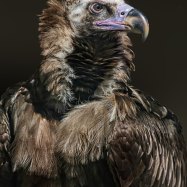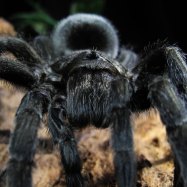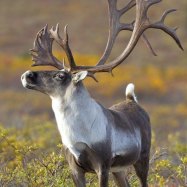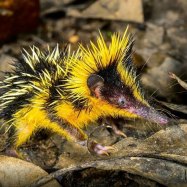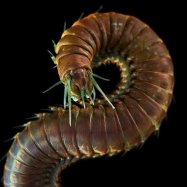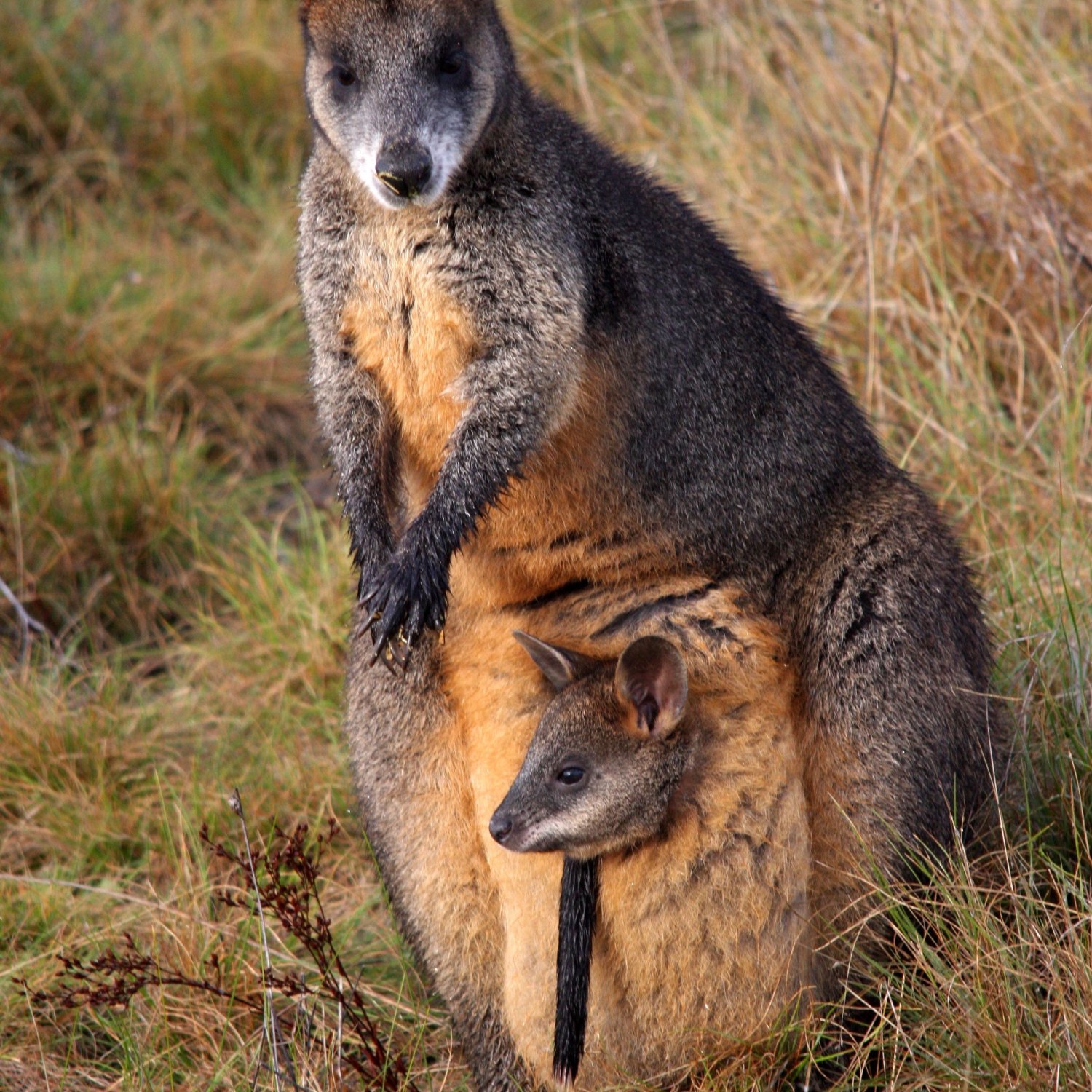
Wallaby
60 - 120 cm (23 - 47 inches)
Wallabies are a unique type of marsupial found in Australia, Tasmania, and New Guinea. These adorable animals belong to the Macropodidae family and have a compact and muscular body shape. They range from 60 to 120 cm in length, making them a sight to behold in their natural habitat. Keep a lookout for these curious and energetic creatures on your next trip to Australia! #Wallaby #Australia #Tasmania #NewGuinea
Animal Details Summary:
Common Name: Wallaby
Kingdom: Animalia
Habitat: Grasslands, forests, and scrublands
The Amazing Wallaby: A Small but Mighty Australian Marsupial
Tucked away in the vast grasslands, forests, and scrublands of Australia and surrounding islands, lives one of the most unique and fascinating animals in the world – the wallaby. With its compact and muscular body, various shades of brown and gray coloration, and herbivorous feeding method, this adorable creature is a true marvel of nature. Let's dive into the world of the wallaby and learn more about its incredible features and characteristics.Firstly, let's get to know the wallaby a little better from a scientific standpoint Wallaby. The scientific name for a wallaby is Macropus, which means "big foot" in Latin, and is a fitting name for this marsupial as they have large hind feet that they use for hopping. Wallabies belong to the Animalia kingdom, which includes all living things that are made up of cells, can move independently, and consume food. They are classified under the phylum Chordata, which includes all animals that have a backbone or spinal cord. Wallabies are also part of the class Mammalia, which includes all warm-blooded animals that give birth to live young and nourish them with milk. Within the mammalian class, wallabies belong to the order Diprotodontia, which encompasses marsupials with two large front teeth. Finally, wallabies are part of the macropodidae family, which includes marsupials with large hind legs and adapted for hopping.
Now that we know about the scientific classification of a wallaby let's focus on their geographical distribution and habitat. Wallabies are endemic to Australia and nearby islands such as Tasmania and New Guinea. However, due to human intervention, wallabies have been introduced to other countries such as New Zealand and the United Kingdom Woolly Monkey. In their native habitats, wallabies can be found in a wide range of environments, including grasslands, forests, and scrublands. They are highly adaptable animals and can thrive in a variety of conditions. However, they are most commonly found in areas with plenty of vegetation and access to water, as they are herbivorous animals.
Speaking of their feeding methods, wallabies are avid herbivores, meaning they only consume plants. They have a specialized digestive system that allows them to efficiently extract nutrients from the plants they eat. Their diet mainly consists of grasses, leaves, and shrubs, but they have also been known to eat certain fruits, roots, and even fungi. They are very efficient eaters and can quickly graze large areas in search of food. Their herbivorous diet is not only essential for their survival, but it also plays a vital role in maintaining the balance of their ecosystem.
One of the most remarkable features of wallabies is their body shape and size. They have a compact and muscular body, with a large head and relatively small front legs. Their hind legs, on the other hand, are incredibly powerful and adapted for hopping. In fact, wallabies are excellent jumpers and can hop at impressive speeds of up to 30 miles per hour! Their strong hind legs also allow them to quickly change direction while jumping, making them difficult prey for predators. In addition to their powerful legs, wallabies also have a long, muscular tail that helps them maintain balance while hopping and serves as a prop when resting or grooming.
In terms of size, wallabies can range from 60 to 120 cm (23 - 47 inches) in length, making them relatively small animals compared to other marsupials like kangaroos. Their weight can also vary significantly, with a range of 2.5 - 25 kg (5.5 - 55 lbs), depending on the species. The smallest wallaby species is the Dusky Pademelon, which is only about 45 cm (18 inches) in length and weighs around 5 kg (11 lbs). On the other end of the spectrum, the Red Kangaroo, although technically not classified as a wallaby, is the largest marsupial and can weigh up to 90 kg (200 lbs).
Now that we have learned about the physical features of wallabies let's examine their coloration. Despite their name, wallabies come in various shades of brown and gray, and their color patterns can vary depending on the species. The most common colors are brown, gray, and reddish-brown, with some species having a mottled or speckled appearance. This coloration serves as a form of camouflage, allowing them to blend in seamlessly with their surroundings as a defense mechanism against predators.
Speaking of predators, wallabies have a few natural enemies in the wild, including dingoes, feral cats, and domestic dogs. However, the greatest threat to their survival is human interference. With the increasing human population and development of their natural habitats, wallabies are facing habitat loss and fragmentation, making it difficult for them to find food and shelter. They are also at risk of being hit by vehicles as they often cross roads in search of food or water. Additionally, in some parts of their native habitats, wallabies are hunted for their meat and fur, further endangering their populations.
Despite the challenges they face, efforts are being made to protect and conserve wallaby populations. In Australia, wallabies are legally protected, and there are laws in place to regulate hunting and control their populations. Conservation organizations are also working towards preserving and restoring wallaby habitats and raising public awareness about the importance of these animals in their ecosystems. With these efforts, we can hope to see wallabies thriving in the wild for generations to come.
In conclusion, the wallaby is more than just a small and adorable marsupial from Australia. With its unique physical features, herbivorous feeding methods, and vital role in maintaining the balance of its ecosystems, this animal is a true marvel of nature. As we continue to learn more about wallabies, it is our responsibility to protect and preserve their habitats and ensure their survival in the wild. So, let's celebrate and appreciate this amazing creature and do our part in protecting its existence.

Wallaby
Animal Details Wallaby - Scientific Name: Macropus
- Category: Animals W
- Scientific Name: Macropus
- Common Name: Wallaby
- Kingdom: Animalia
- Phylum: Chordata
- Class: Mammalia
- Order: Diprotodontia
- Family: Macropodidae
- Habitat: Grasslands, forests, and scrublands
- Feeding Method: Herbivorous
- Geographical Distribution: Australia and surrounding islands
- Country of Origin: Australia
- Location: Australia, Tasmania, New Guinea
- Animal Coloration: Various shades of brown and gray
- Body Shape: Compact and muscular
- Length: 60 - 120 cm (23 - 47 inches)

Wallaby
- Adult Size: Small to medium-sized
- Average Lifespan: 10 - 15 years
- Reproduction: Marsupial
- Reproductive Behavior: Mating occurs throughout the year
- Sound or Call: Vocalize through various calls
- Migration Pattern: Non-migratory
- Social Groups: Usually solitary or live in small groups
- Behavior: Mostly crepuscular and nocturnal
- Threats: Habitat loss, hunting, predation
- Conservation Status: Least Concern
- Impact on Ecosystem: Important for seed dispersal and vegetation control
- Human Use: Tourism, hunting, meat, fur
- Distinctive Features: Large hind legs, long tail
- Interesting Facts: Wallabies are smaller relatives of kangaroos
- Predator: Dingoes, foxes, eagles, snakes
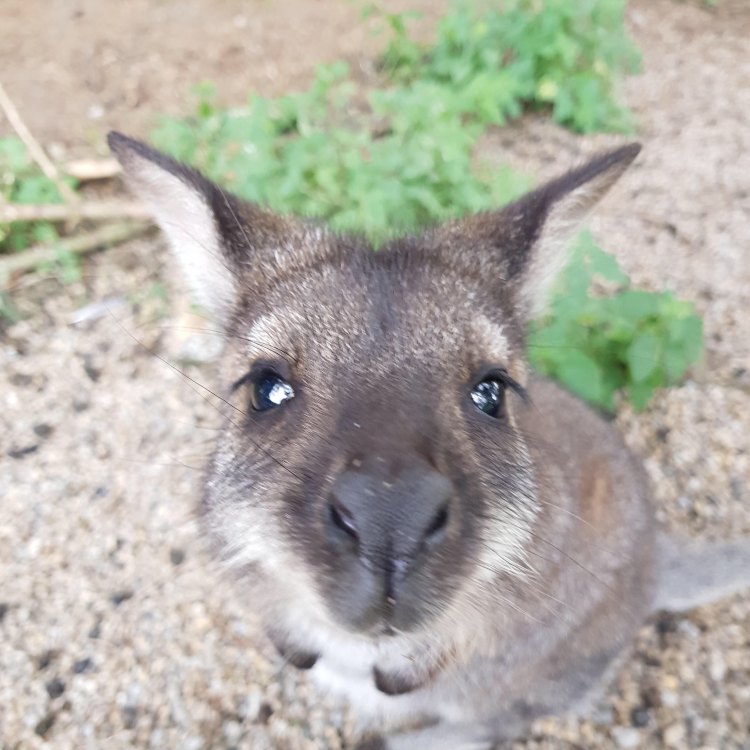
Macropus
The Wild and Wonderful World of Wallabies: Discovering Australia's Small Giants
When we think of Australian wildlife, kangaroos are usually the first that come to mind. However, there is another iconic animal that often goes overlooked – the wallaby. These small to medium-sized marsupials are a unique and integral part of Australia's ecosystem, with fascinating features and behaviors that have captured the interest of people around the world. In this article, we will take a deep dive into the wild and wonderful world of wallabies, learning about their size, lifespan, reproduction, behavior, conservation status, and more PeaceOfAnimals.Com.Small Giants: The Adult Size of Wallabies
Wallabies are part of the Macropodidae family, which also includes kangaroos and wallaroos. They range in size from the smallest species, the dwarf wallaby, which is about the size of a rabbit, to the larger ones, such as the red-necked and swamp wallabies, which can weigh up to 50 pounds. This variety in size is influenced by factors such as habitat, diet, and genetics.Average Lifespan: A Decade or More
Wallabies have an average lifespan of 10 to 15 years, though some have been known to live up to 20 years in captivity. Their lifespan is dependent on different factors, including the species, environmental conditions, and human impact.Marsupial Reproduction: A Unique Process
One of the most distinctive features of marsupials, including wallabies, is their reproductive process. Unlike other mammals, who have a placenta to nourish and protect the developing embryo, marsupials have a simple placenta that only functions for a short time. After giving birth to a tiny underdeveloped joey, the mother's pouch becomes the primary source of nourishment and protection for the joey until it fully develops.Mating Behavior: Year-Round Romance
As non-migratory animals, wallabies do not have a specific breeding season Wels Catfish. Mating can occur throughout the year, though there may be seasonal peaks depending on the species and location. Wallabies are promiscuous animals, and both males and females have several mates during their lifespan.Vocalization: Communication Through Calls
Although wallabies are generally quiet animals, they do have a range of vocalizations they use for communication. The most common sound they make is a soft, bouncing noise used to attract mates, establish territory, and warn of danger. Wallabies also make a clucking sound to communicate with their joeys and other members of their social group.Migration Pattern: Staying Put
Unlike many other animal species, wallabies are non-migratory. They do not move to different locations at specific times of the year or for specific reasons. This behavior is due to their adaptation to a specific habitat and food source, allowing them to successfully live in the same area throughout their lifespan.Social Groups: Solitary or Small but Mighty
Wallabies are primarily solitary animals, though they do form small social groups at times. Depending on the species, they may live in small groups of 2-3 individuals or, in the case of the red-necked wallabies, in larger groups of up to 30 individuals. These groups are often comprised of related females and their young. Males usually live alone or in bachelor groups, only joining the females during mating season.Behavior: Crepuscular and Nocturnal Creatures
Wallabies are classified as crepuscular and nocturnal creatures, meaning they are most active during the twilight hours and at night. This behavior helps them avoid predators and conserve energy in Australia's harsh climate. Wallabies are also known for their agility and ability to jump great distances, with some species reaching heights of over six feet in a single bound.Threats to Wallabies: Humans and Habitat Loss
Unfortunately, like many Australian animals, wallabies are facing threats to their survival. Habitat loss due to human development is one of the greatest dangers for wallabies. As more land is cleared for agriculture and urbanization, wallabies lose their homes and sources of food. This also leads to increased competition for resources and can result in conflict between humans and wallabies.Other Threats: Hunting and Predation
Wallabies are also hunted for their meat and fur, as well as for sport. While regulated hunting can be sustainable, unsustainable and illegal hunting practices have a significant impact on wallaby populations. Additionally, wallabies are preyed upon by natural predators such as dingoes, foxes, eagles, and snakes, making them vulnerable in their natural habitat.Conservation Status: Least Concern but Need for Greater Protection
Currently, wallabies are listed as "Least Concern" on the International Union for Conservation of Nature's (IUCN) Red List. This means they are not facing immediate or significant threats to their survival as a species. However, this does not mean wallabies do not need protection. As the threats they face continue to increase, it is crucial to monitor their populations and protect their habitats to prevent any decline in the future.Impact on Ecosystem: Vital for Seed Dispersal and Vegetation Control
Wallabies play a vital role in Australia's ecosystem, contributing to seed dispersal and vegetation control. As herbivores, they help regulate plant growth and maintain a balanced ecosystem. Wallabies also act as seed dispersers, aiding in plant reproduction and creating new habitat for other species.Human Use: Tourism, Hunting, and More
Wallabies have long been an important animal for humans in Australia, both in traditional Indigenous cultures and in modern society. They attract tourists from around the world, bringing in significant revenue for Australia's economy. Wallabies are also hunted for their meat and fur, though hunting is regulated to prevent overexploitation. In the past, their fur was also used for clothing and accessories, though this practice has decreased in recent years due to ethical concerns.Distinctive Features: The Significance of Hind Legs and Tails
Wallabies possess several distinctive features that make them easily recognizable among other Australian animals. Their hind legs are significantly larger and more muscular than their front legs, allowing them to jump and hop with incredible speed and agility. This ability also helps them escape predators and travel long distances in search of food and water. Additionally, wallabies have long, thick tails that serve as a balance and support when they are hopping and jumping.Interesting Facts: The Smaller Relatives of Kangaroos
One of the most interesting facts about wallabies is that they are the smaller relatives of kangaroos. Despite their similar appearance and behaviors, there are some clear differences between these two iconic Australian animals. Wallabies are smaller and more solitary than kangaroos, they have a more varied diet, and their tails are not as long and powerful as kangaroos. However, both share the unique characteristic of being able to hop and jump with incredible speed and grace.Predators: Natural Enemies of Wallabies
As mentioned, wallabies face threats from natural predators such as dingoes, foxes, eagles, and snakes. These animals have adapted to hunt wallabies and can have a significant impact on their populations if not kept in balance. Encroachment on their natural habitats can also bring them into conflict with humans, resulting in further threats and challenges.The Importance of Protecting Wallabies and Their Habitat
Ultimately, wallabies are an essential part of Australia's ecosystem, and their survival is critical for maintaining a healthy and balanced environment. It is crucial to protect their habitats and address the threats they face to ensure their populations remain stable. This can be achieved through measures such as sustainable land use practices, responsible hunting regulations, and conservation efforts.Conclusion: Appreciating the Wild and Wonderful Wallabies
In conclusion, wallabies are fascinating creatures with unique characteristics and behaviors that make them stand out in the diverse landscape of Australian wildlife. From their small size and long lifespan to their reproduction and distinctive features, these marsupials have captured the hearts of many and continue to play a vital role in their ecosystem. As humans, it is our responsibility to protect and appreciate these wild and wonderful animals, ensuring that they continue to thrive for generations to come.
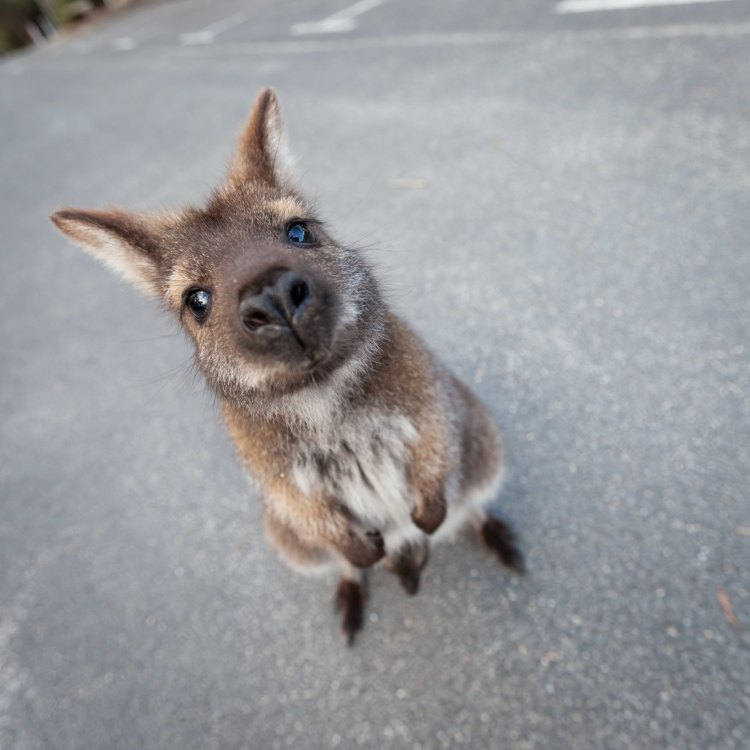
The Amazing Wallaby: A Small but Mighty Australian Marsupial
Disclaimer: The content provided is for informational purposes only. We cannot guarantee the accuracy of the information on this page 100%. All information provided here may change without prior notice.

